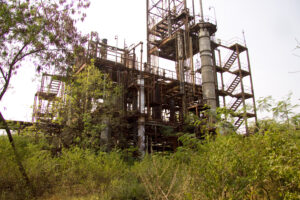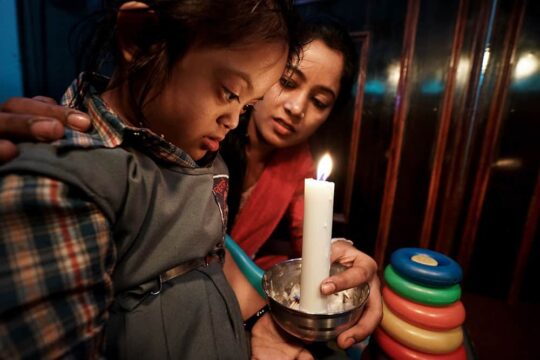Union Carbide Corporation is subject to a federal class-action lawsuit (Sahu II v. UCC), in the Southern District New York Court, and this case focuses on damage caused by the water contamination resulting from toxic chemicals leaching from abandoned Union Carbide waste into the groundwater aquifer.
The US courts accept that this is a separate matter from the 1984 gas disaster and has not been part of any pre-existing settlement. UCC has argued in New York that only an Indian court can order a clean-up in Bhopal. However both UCC and Dow have pleaded (in the Madhya Pradesh court) that Indian courts have no jurisdiction over them.
A previous case, Sahu I, asserted personal injury claims and was filed in 2004. In November 2006, the District Court for the Southern District of New York granted summary judgment to the defendants, finding them not liable for damages alleged. Sahu II asserts property damage claims using different plaintiffs.
EarthRights International (ERI), have been, amongst others, a counsel for the plaintiffs and here follows their succinct explanation of the Sahu I & Sahu II Class actions:
Sahu v. Union Carbide Corp. refers to two separate lawsuits on behalf of residents of Bhopal, India, against Union Carbide Corp. for water pollution. A poisonous gas leak from the same plant killed over 5,000 people in 1984. ERI has also served as co-counsel on behalf of different plaintiffs in a previous case arising from water pollution from the plant, but that case was ultimately dismissed.
The first Sahu case, Sahu I, asserts personal injury claims and was filed in 2004. In November 2006, the District Court for the Southern District of New York granted summary judgment to the defendants, finding them not liable for damages alleged. The Second Circuit, however, vacated the judgment on grounds that the trial court did not provide the plaintiffs notice that it intended to rule based upon the limited evidence that was before the court, and sent the case back down to the District Court for further proceedings.
In 2007, while Sahu I was on appeal, Sahu II was filed, asserting property damage claims. Although the named plaintiffs in Sahu II are not identical to those in Sahu I, because the facts at issue in the cases are similar the District Court granted the plaintiffs’ motion to stay Sahu II in 2007.
On June 26, 2012, the District Court once again granted summary judgment to the defendants in Sahu I. The plaintiffs appealed to the U.S. Court of Appeals for the Second Circuit, which heard oral argument on June 17, 2013. On June 27, 2013, the Second Circuit upheld the district court’s dismissal.
After the Second Circuit’s order, the Court dissolved the stay in Sahu II, and UCC moved for summary judgment arguing that Sahu II should be dismissed on the same grounds as Sahu I. The Sahu II plaintiffs opposed that motion, presenting evidence of UCC’s responsibility that was not before the Court in Sahu I. In particular, plaintiffs presented the declarations of two eminent waste disposal experts, who show that UCC’s manufacturing design and “high risk” waste management strategy caused the pollution. Plaintiffs also submitted the declaration of L.J. Couvaras, who was the Project Manager for the construction of the plant, as well as that of a UCIL employee, both of whom demonstrate that Couvaras was a UCC employee when he oversaw and approved all design done in India and construction. This shows that UCC had final authority over all design, including of the waste disposal system.
On July 30, 2014, the District Court granted summary judgment in Sahu II. In his decision, Judge Keenan improperly dismissed Couvaras’s declaration – which he described as unsupported – despite the fact that judges are not supposed to weigh the persuasiveness of evidence at the summary judgment stage.
The plaintiffs appealed this decision in November 2014 in the U.S. Court of Appeals for the Second Circuit, contesting a lower court’s decision that UCC could not be sued for ongoing pollution.
In addition to EarthRights International (ERI), counsel for the plaintiffs include or have included Sharma & DeYoung LLP, Curtis Trinko, Hausfeld LLP, and Cohen Milstein Sellers & Toll PLLC.
After Judge Keenan’s dismissal, in July 2014, Marco Simons , Legal Director of EarthRights International, assisting the Bhopal plaintiffs in the case said:
“John Couvaras, the project manager who directly oversaw the construction of the Bhopal plant, testified that he worked for Union Carbide at the time. A manager from Union Carbide’s Indian subsidiary confirmed this assertion.”
“Astonishingly, the court simply didn’t care. Couvaras’s own testimony about the company he worked for is ‘unsubstantiated,’ (Judge) Keenan decided. Instead, Union Carbide’s statements that Couvaras worked for its subsidiary were ‘conclusive’ evidence. If you ever thought you knew your own employer’s identity, think again — your testimony on that subject isn’t even really evidence.”
“After the Bhopal debacle, Union Carbide packed up and left a mess that’s still poisoning residents and their environment, and its mess is now Dow’s problem. People living near the plant continue to suffer physical ailments, live on contaminated property, and drink poisoned water. Not only have the victims been denied justice at every door they’ve knocked on, they have also been sued for seeking justice in the first place.”
(Note: Dow has tried to sue Bhopal activists four different times in Indian courts over their continued protests against the company).



